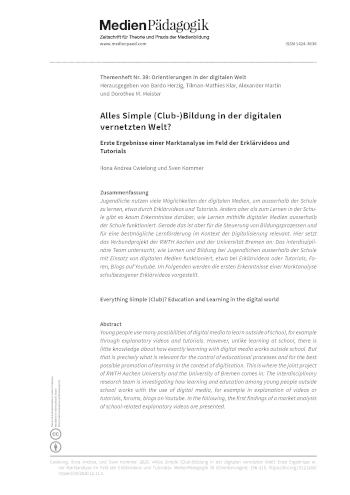Abstract
Young people use many possibilities of digital media to learn outside of school, for example through explanatory videos and tutorials. However, unlike learning at school, there is little knowledge about how exactly learning with digital media works outside school. But that is precisely what is relevant for the control of educational processes and for the best possible promotion of learning in the context of digitisation. This is where the joint project of RWTH Aachen University and the University of Bremen comes in: The interdisciplinary research team is investigating how learning and education among young people outside school works with the use of digital media, for example in explanation of videos or tutorials, forums, blogs on Youtube. In the following, the first findings of a market analysis of school-related explanatory videos are presented.
References
Bachmair, Ben. 2009. Medienwissen für Pädagogen. Medienbildung in riskanten Erlebniswelten. Wiesbaden: VS. https://doi.org/10.1007/978-3-531-91391-9.
Bitkom, Hrsg. 2014. Jung und vernetzt. Kinder und Jugendliche in der digitalen Gesellschaft. Berlin: BITKOM - Bundesverband Informationswirtschaft, Telekommunikation und neue Medien e. V. https://www.bitkom.org/sites/default/files/file/import/BITKOM-Studie-Jung-und-vernetzt-2014.pdf.
Bitkom. 2015. Mehr als jeder Dritte schaut Video-Anleitungen im Internet. Zugriff 11.04.2019. https://www.bitkom.org/Presse/Presseinformation/Mehr-als-jeder-Dritte-schaut-Video-Anleitungen-im-Internet.html.
Bloom, Benjamin Samuel, Hrsg. 1956. Taxonomy of Educational Objectives: The Classification of Educational Goals. Handbook I. Cognitive Domain. New York; London: McKay; Longman.
Brinda, Thorsten, Nils Brüggen, Ira Diethelm, Thomas Knaus, Sven Kommer, Christine Kopf, Petra Missomelius, Rainer Leschke, Friederike Tilemann, und Andreas Weich. 2019. «Frankfurt-Dreieck zur Bildung in der digital vernetzten Welt. Ein Interdisziplinäres Modell». Medienimpulse 57/19. https://doi.org/10.21243/mi-02-19-05.
Feierabend, Sabine, Theresa Plankenhorn, und Thomas Rathgeb. 2017. «JIM 2017. Jugend, Information, (Multi-) Media. Basisstudie zum Medienumgang 12- bis 19-Jähriger in Deutschland». Medienpädagogischer Forschungsverbund Südwest. https://www.mpfs.de/fileadmin/files/Studien/JIM/2017/JIM_2017.pdf.
Feierabend, Sabine, Thomas Rathgeb, und Theresa Reutter. 2018. «JIM 2018. Jugend, Information, Medien. Basisstudie zum Medienumgang 12- bis 19-Jähriger in Deutschland». Medienpädagogischer Forschungsverbund Südwest. https://www.mpfs.de/fileadmin/files/Studien/JIM/2018/Studie/JIM2018_Gesamt.pdf.
Jörissen, Benjamin, und Winfried Marotzki. 2009. Medienbildung – Eine Einführung. Bad Heilbrunn: Klinkhardt.
Kommer, Sven. 2020. «Lernen 4.0». In Handbuch Industrie 4.0: Recht, Technik, Gesellschaft, hrsg. v. Walter Frenz, 1261–72. Berlin, Heidelberg: Springer Berlin Heidelberg. https://doi.org/10.1007/978-3-662-58474-3_64.
Niesyto, Horst. 2003. «VideoCulture – Gegenstand, Methoden, Ergebnisse». In VideoCulture. Video und interkulturelle Kommunikation, hrsg. v. Horst Niesyto, 157–172. München: kopaed.
Rat für Kulturelle Bildung, Hrsg. 2019. Jugend/Youtube/Kulturelle Bildung - Horizont 2019 Studie: eine repräsentative Umfrage unter 12- bis 19-jährigen zur Nutzung kultureller Bildungsangebote an digitalen Kulturorten. Essen: Rat für Kulturelle Bildung e.V. https://www.rat-kulturelle-bildung.de/fileadmin/user_upload/pdf/Studie_YouTube_Webversion_final.pdf.
Richard, Birgit, und Birte Philippi. 2016. «Tutorials, Let‘s play und Erklärfilme auf YouTube. Das Internet als neuartiger Bildungsraum». In Kritische Bildungsforschung. Standortbestimmungen und Gegenstandsfelder, hrsg. v. Anne Schippling, Cathleen Gruner und Nicolle Pfaff,180–190. Opladen: Barbara Budrich. https://doi.org/10.2307/j.ctvdf014p.14.
Rummler, Klaus, und Karsten Wolf. 2012. «Lernen mit geteilten Videos: aktuelle Ergebnisse zur Nutzung, Produktion und Publikation von online-Videos durch Jugendliche». In Medien – Wissen – Bildung. Kulturen und Ethiken des Teilens, hrsg. v. Wolfgang Sützl, Felix Stalder, Ronald Maier, Theo Hug, 253–266. Innsbruck: University Press. https://www.uibk.ac.at/iup/buch_pdfs/9783902811745.pdf.
Valentin, Katrin. 2018. «Subjektorientierte Erforschung des Aneignungsverhaltens von Rezipierenden von Video-Tutorials». Journal for educational research online 10 (1): 52–69. http://nbn-resolving.org/urn:nbn:de:0111-pedocs-154137.
Wolf, Karsten D. 2015a. «Produzieren Jugendliche und junge Erwachsene ihr eigenes Bildungsfernsehen? Erklärvideos auf YouTube». TelevIZIon 28 (1): 35–39. http://www.br-online.de/jugend/izi/deutsch/publikation/televizion/28_2015-1/Wolf-Produzieren_Jugendliche_und_junge_Erwachsene.pdf.
Wolf, Karsten. 2015b. «Bildungspotenziale von Erklärvideos und Tutorials auf YouTube. Audio-Visuelle Enzyklopädie, adressatengerechtes Bildungsfernsehen, Lehr-Lern-Strategie oder partizipative Peer Education?». merz 59/15, 30–36.

